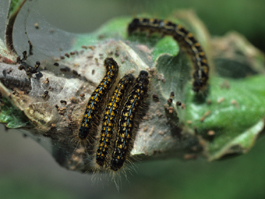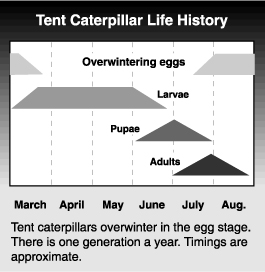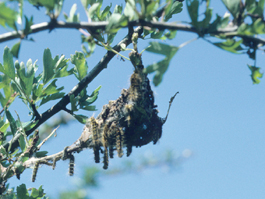by Jay F. Brunner, originally published 1993
(Lepidoptera: Lasiocampidae)
Western tent caterpillar
Malacosoma fragilis (Stretch)
Forest tent caterpillar
Malacosoma disstria Hübner

The western tent caterpillar is found throughout the western United States and Canada. The species found in the East is the common eastern tent caterpillar, Malacosoma americana (Fabricius). There are several species of tent caterpillars in the western United States, but all have similar life histories, habits and appearances. They are not common in most commercial orchards, but tents are conspicuous in abandoned trees or native habitats. They are considered a minor pest of fruit trees.\The forest tent caterpillar is found throughout North America. While the larvae do trail webbing wherever they go, this webbing does not function as a true tent. However, the webbing may completely cover limbs and foliage. When not feeding, the larvae gather in masses on branches or the tree trunk.
Hosts
The western tent caterpillar attacks a wide range of hosts including apple, peach, plum, cherry, pear, wild rose, poplar and willow. The forest tent caterpillar prefers maple but will also feed on the foliage of most types of fruit trees.
Life stages
Egg
The egg is elongated and about 1/25 inch (1 mm) long. Eggs are laid in masses of as many as 400. The masses are covered with a brownish gray material that protects them from the weather.
Larva
The fully grown western tent caterpillar larva is about 2 inches (50 mm) long and covered with fine, soft yellowish brown hairs. The body is pale blue-gray on the sides with a distinctive light stripe down the middle of its back and bluish spots to either side of the mid-line. The fully grown forest tent caterpillar larva can be distinguished from the western tent caterpillar by the row of wedge- or club-shaped cream spots down its back in place of the stripe.
Pupa
The pupa is brown and about 3/4 inch (19 mm) long. It is enclosed in a silken cocoon of loosely woven white silk, which is commonly dusted over with a fine yellowish powder.
Adult
The western tent caterpillar moth is a dull, reddish brown with a pair of parallel oblique whitish bands crossing the front wing. On the forest tent caterpillar the bands are brown.
Life history
 Tent caterpillars have one generation each year. Tent caterpillars overwinter as eggs, which hatch in spring when new foliage starts to appear. The young larvae move to a crotch and spin a dense web. This web gradually expands as the larvae grow and the feeding area required to sustain the colony increases. Larvae mature in 4 to 6 weeks and by mid-May through June can be seen wandering in search of places to pupate. Moths emerge in June and July, then mate and lay eggs, which hatch the following spring.
Tent caterpillars have one generation each year. Tent caterpillars overwinter as eggs, which hatch in spring when new foliage starts to appear. The young larvae move to a crotch and spin a dense web. This web gradually expands as the larvae grow and the feeding area required to sustain the colony increases. Larvae mature in 4 to 6 weeks and by mid-May through June can be seen wandering in search of places to pupate. Moths emerge in June and July, then mate and lay eggs, which hatch the following spring.
Damage
Larvae of a single tent caterpillar colony can strip the leaves from a small tree if allowed to develop and are more of a threat in nurseries or newly planted orchards. On larger trees they are only a serious problem if there are several colonies on the same tree. While fruit is not directly attacked, fruit on branches that have had leaves consumed will not develop normally.
Monitoring

Check for tents or webbing of these insects, which are easy to spot in the orchard.
Biological control
Tent caterpillars are attacked by numerous natural enemies, including birds, predaceous beetles and bugs, and parasitic wasps and flies. They are at times devastated by outbreaks of bacterial or viral diseases, especially if local populations become extremely dense. The potential for biological control of tent caterpillars is great and probably accounts for much of the mortality in native habitats.
Management
Small tents of the western tent caterpillar can be pruned and removed from the orchard. Spot treatments with insecticides are also a viable option for control.